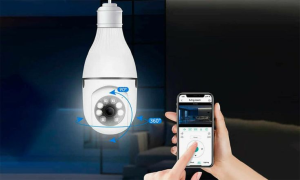Light Bulb Security Camera
A light bulb security camera, also known as a smart bulb camera or a light bulb camera, is a combination of a surveillance camera and a smart LED light bulb. It is designed to provide both lighting and security monitoring capabilities in one device. In the ever-evolving world of smart home technology, light bulb security cameras have emerged as a versatile solution for homeowners seeking both illumination and surveillance capabilities. These innovative devices seamlessly integrate lighting and security features into a single unit, making them a popular choice for enhancing home security.
In this article, we will explore the various aspects of light bulb security cameras, including their features, benefits, installation, and factors to consider when choosing one for your home.
Light Bulb Security Camera: A Bright Idea for Home Security
Light bulb security cameras are a game-changer in the world of home surveillance. These innovative devices combine the functionality of a traditional light bulb with the power of a security camera, providing you with an inconspicuous yet effective way to monitor your home. In this comprehensive guide, we’ll delve into everything you need to know about light bulb security cameras and how to make the most of them for your home’s safety. Also, read about Remote Video Surveillance: All You Need to Know
Why Choose a Light Bulb Security Camera?
In this section, we’ll explore the advantages of opting for a light bulb security camera over traditional security systems. Discuss how they blend seamlessly into your home, provide 360-degree coverage, and offer remote monitoring capabilities.
Features of Light Bulb Security Cameras
Video Surveillance
Light bulb security cameras come equipped with high-definition (HD) or even 4K resolution cameras that capture clear video footage. This video capability allows you to monitor your property effectively.
Live Streaming
Many models offer live streaming functionality through a dedicated smartphone app or computer interface, enabling real-time monitoring from anywhere.
Dual Functionality
Light bulb security cameras serve a dual purpose. They can illuminate an area like a regular light bulb while also capturing video footage and sometimes audio for security and surveillance purposes.
Motion Detection
Integrated motion sensors in these cameras can detect movement within their field of view. When triggered, they send alerts and notifications to your mobile device, keeping you informed of potential security events.
Two-Way Audio
Some light bulb cameras feature two-way audio, facilitating both listening and communication through a built-in speaker and microphone. This feature is handy for interacting with family members, visitors, or even pets remotely.
Night Vision
To maintain surveillance during low-light or nighttime conditions, most light bulb security cameras employ infrared (IR) LEDs for night vision capabilities, ensuring 24/7 monitoring.
Mobile App Control
Control and configuration of camera settings are accessible via a dedicated mobile app. Users can adjust light brightness, set motion detection zones, and review recorded footage with ease.
Storage Options
Recorded video footage can be stored either in the cloud or on a microSD card (or a combination of both). This flexibility allows users to choose their preferred method of storage.
Integration with Smart Home Systems
Many light bulb security cameras seamlessly integrate into popular smart home ecosystems, such as Amazon Alexa or Google Assistant. This integration allows for voice control and inclusion in existing smart home setups. For more interesting facts visit our website bytetechsolution.com

Light Bulb Security Camera
Installation and Usage
1. Easy Installation
Installing a light bulb security camera typically involves replacing a standard light bulb with the camera-equipped version. Connecting to your Wi-Fi network and configuring settings through the manufacturer’s app is straightforward.
2. Versatile Use Cases
These cameras find application in various locations, including front porches, hallways, garages, and outdoor areas, providing both illumination and surveillance capabilities.
Multiple Use Cases
Light bulb security cameras can be used in various locations, such as front porches, hallways, garages, and outdoor areas, providing both illumination and security surveillance.
Cost
Prices can vary widely depending on the features and capabilities of the device. Generally, they can range from affordable options to more expensive, high-end models.
Conclusion
Light bulb security cameras represent a significant advancement in home security technology. Their ability to combine lighting and surveillance in a single unit makes them an attractive choice for homeowners looking to enhance their security measures. When considering a light bulb security camera, it’s essential to evaluate factors like video quality, storage options, smart home compatibility, and specific security requirements to make an informed choice.
FAQs
Q: How often should I clean my light bulb security camera lens?
It’s advisable to clean the camera lens every few months or as needed to ensure clear footage.
Q: Can I install multiple light bulb security cameras in my home?
Yes, you can install multiple cameras to cover different areas of your home, providing comprehensive surveillance.
Q: Are light bulb security cameras compatible with smart home systems like Alexa or Google Assistant?
Many light bulb security cameras are compatible with popular smart home systems, allowing you to integrate them seamlessly into your existing setup. Check the product specifications for compatibility details.
Q:What is the cost of a light bulb security camera?
The cost can vary widely based on brand, features, and quality. Prices typically range from $50 to $200 or more, depending on the specifications and capabilities of the camera.
Q:Are light bulb security cameras compatible with smart home systems like Alexa or Google Home?
Many light bulb security cameras are compatible with popular smart home ecosystems. You can often integrate them with voice assistants and control them through voice commands.
